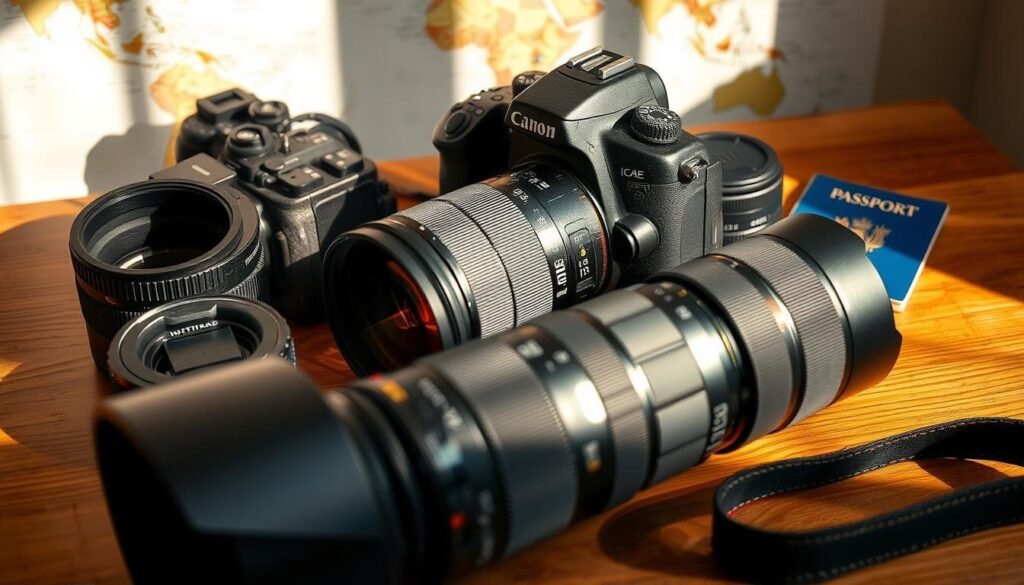How to Fly with a DSLR Camera: Traveling with your DSLR camera can be tricky, especially at airport security and airline rules. It’s key to know the TSA’s rules and how to pack your camera equipment right.
Before your flight, learn the TSA’s rules on camera gear in carry-ons. Know what you can bring in your bag and what must go in checked luggage. This way, you’ll skip any security problems at the last minute.
Contents
- 1 Understanding TSA Regulations for Camera Equipment
- 2 Can You Bring a DSLR Camera on a Plane?
- 3 Packing Your DSLR Camera for Air Travel
- 4 Navigating Airport Security with Camera Gear
- 5 Protecting Your Camera During Flight
- 6 International Travel with DSLR Equipment
- 7 Conclusion: How to Fly with a DSLR Camera?
- 8 FAQ
- 8.1 What are the TSA regulations for carrying a DSLR camera on a plane?
- 8.2 Can I bring my DSLR camera as a carry-on item if it has a battery?
- 8.3 How do I pack my DSLR camera for air travel to prevent damage?
- 8.4 What should I do if my DSLR camera is selected for additional screening at airport security?
- 8.5 Can I bring my DSLR camera on an international flight?
- 8.6 What are the best practices for keeping my camera gear safe during flight?
Understanding TSA Regulations for Camera Equipment
Before your flight, learn about TSA rules for camera gear. The Transportation Security Administration has clear guidelines for carrying camera equipment on planes. These rules differ based on whether you check your gear or carry it with you.
You can bring your DSLR camera and lenses in your carry-on. But, you might face extra checks. The TSA could ask you to take out your camera and lenses for X-ray screening. Make sure your camera gear is easy to remove for screening.
Some items, like lithium batteries, have special rules. Spare lithium batteries are okay in carry-ons but not in checked bags. It’s wise to keep your valuable camera in your carry-on to avoid damage.
| Item | Carry-On | Checked |
|---|---|---|
| DSLR Camera | Allowed | Allowed |
| Lenses | Allowed | Allowed |
| Lithium Batteries | Allowed (Spare) | Not Allowed (Spare) |
Knowing these rules helps you prepare for your next flight with your camera.
Can You Bring a DSLR Camera on a Plane?
Before you pack for your next trip, check if you can bring your DSLR camera on a plane. Most of the time, you can, but there are rules you need to follow.
Media Credentials and Exemptions
If you work in media, you might get special treatment with your DSLR camera. You’ll need media credentials like a press pass. Some places have special rules for media people, so it’s smart to check first.
Also, know the rules for oversized equipment. If your camera gear is too big or heavy, you might need to check it or make other plans with your airline.
Airlines have different rules for big camera gear. Some let you carry big bags on board, while others make you check them.
| Airline | Oversized Equipment Policy | Media Credential Exemption |
|---|---|---|
| American Airlines | Allowed as checked baggage | Yes, with valid media credentials |
| Delta Air Lines | Special handling required | Yes, with prior arrangement |
| United Airlines | Allowed as carry-on or checked | Yes, with valid media credentials |
Always check with your airline before your trip. This way, you can make sure your DSLR camera travels smoothly.
Packing Your DSLR Camera for Air Travel
When flying, how you pack your DSLR camera is crucial. Proper packing protects your gear and helps you get through airport security easily.
Creating a Packing Checklist
Start by making a list of your DSLR camera gear. Include your camera body, lenses, batteries, chargers, memory cards, and accessories. This checklist helps you remember everything important.
Use a dedicated camera bag or a padded case in your luggage. This adds extra protection against bumps and scratches.
Protecting Against Moisture and Dust
Moisture and dust can harm your camera. Use silica gel packets or waterproof cases to fight moisture. For dust, keep your camera and lenses in sealed bags or compartments.
Keep your gear organized when packing. Use dividers or pouches to separate items. This makes it easier to find what you need fast.
By following these tips and making a detailed packing list, your DSLR camera and accessories will arrive safely. They’ll be ready for you to capture amazing moments.
To make sure your camera gear passes through airport security easily, follow these tips. Going through security with valuable items like DSLR cameras and lenses can be tough.
Before you go through security, know how to handle your camera gear. Take out your camera and other electronics from your carry-on bags. Then, put them in a bin for X-ray screening. This makes the screening process clearer and less likely to need extra checks.
If you have special or delicate camera equipment, ask for a manual check. This is to prevent damage from the X-ray. Tell the security officer before they scan your items. They will show you how to proceed.
| Equipment | X-ray Friendly | Manual Inspection Recommended |
|---|---|---|
| DSLR Cameras | Yes | No |
| Lenses | Yes | No |
| High-Value or Sensitive Equipment | No | Yes |
By following these steps, you can go throughairport securitywith yourcamera gearmore easily. This way, your equipment stays safe, and you follow the security rules.
Protecting Your Camera During Flight
Keeping your camera safe during flights is key, especially when traveling through different climates. Changes in climate can lead to condensation, which harms your camera.
To keep your DSLR camera safe, think about using a hardcase or a padded bag. These can absorb shocks and protect your gear from outside pressures.
Condensation happens when your camera faces big temperature changes. To fight this, use silica gel packets to soak up moisture. Or, keep your camera in a sealed bag until it warms up to the new temperature.
- Use silica gel packets to absorb moisture.
- Keep your camera in a sealed bag until it adjusts to the ambient temperature.
- Avoid sudden temperature changes by letting your equipment get used to the new environment.
By following these steps, you can keep your camera safe from climate change and condensation. This way, it will stay in top shape for your entire trip.
International Travel with DSLR Equipment
Before you start your international trip with DSLR gear, learn about customs rules and travel tips. It’s key to know that each country has its own rules for bringing in and taking out camera equipment.
Research the customs rules of your destination to avoid problems when you arrive. Some places need you to say you have DSLR gear and might ask for receipts or professional licenses if you have lots of items or expensive gear.
Here are some tips to make your trip easier:
- Find out if your destination has any rules on camera equipment.
- Keep your DSLR gear in its original box or a strong case.
- Have proof of who owns your equipment.

Being well-informed and ready will let you enjoy your trip with your DSLR equipment. Knowing and following customs rules will make your photo adventure successful and fun.
Conclusion: How to Fly with a DSLR Camera?
As you get ready for your next trip, remember the key tips for flying with your DSLR camera. Knowing TSA rules, packing right, and keeping your gear safe during flight are key for a hassle-free trip.
To make your journey smooth, go over these DSLR camera travel tips: check with your airline about camera gear rules, use a strong case, and have your camera ready to go.
By sticking to these tips, you can take great photos on your travels. And you’ll keep your DSLR camera safe and sound.
See Also: Can You Bring a Dead Fish on a Plane?
FAQ
What are the TSA regulations for carrying a DSLR camera on a plane?
The TSA lets you carry DSLR cameras in your carry-on. But, they might need to screen it extra. You’ll have to take it out of its case and put it in a bin for X-ray.
Can I bring my DSLR camera as a carry-on item if it has a battery?
Yes, you can carry your DSLR camera with a battery in your carry-on. Just make sure to protect the battery and keep it in a safe case.
How do I pack my DSLR camera for air travel to prevent damage?
Use a hard case or a padded bag to protect your camera for flying. Wrap it in clothes or bubble wrap to avoid scratches. Carry fragile items in your carry-on.
What should I do if my DSLR camera is selected for additional screening at airport security?
If your camera is picked for extra screening, get ready to take it out of its case. You might need to turn it on to show it works.
Can I bring my DSLR camera on an international flight?
Yes, you can take your DSLR camera on an international flight. Check your airline’s rules and know the customs laws in your destination.
What are the best practices for keeping my camera gear safe during flight?
Keep your camera gear safe by using a protective case. Carry valuable items in your carry-on. Be careful with your gear during the flight and keep it secure when not in use.

Hello, I’m Janiyah Gibbs—a retired flight crew member and former TSA officer from Alaska, USA. At PlaneCarry.com, I share expert insights on what to carry (and avoid) when flying.

